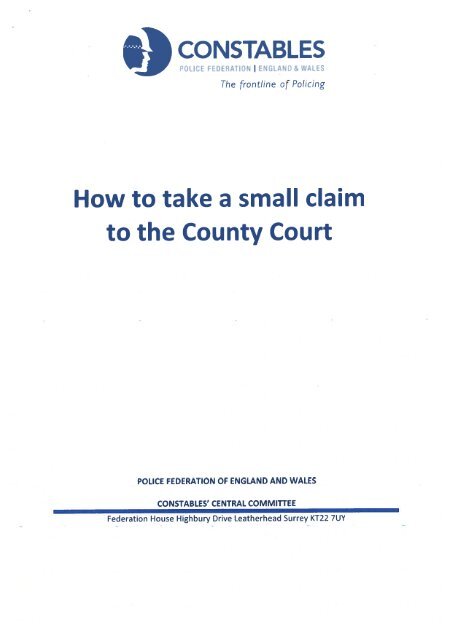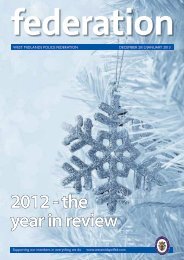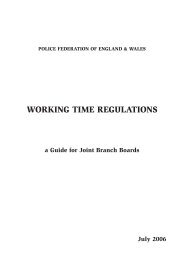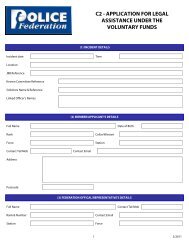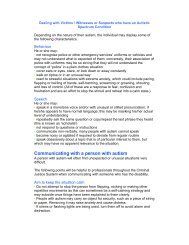How to take a small claim to the County Court - West Midlands ...
How to take a small claim to the County Court - West Midlands ...
How to take a small claim to the County Court - West Midlands ...
- No tags were found...
Create successful ePaper yourself
Turn your PDF publications into a flip-book with our unique Google optimized e-Paper software.
CONSTABLESPOLICE FEDERATION IENGLAND & WALESThe front/me or Policing<strong>How</strong> <strong>to</strong> <strong>take</strong> a <strong>small</strong> <strong>claim</strong><strong>to</strong> <strong>the</strong> <strong>County</strong> <strong>Court</strong>POLICE FEDERATION OF ENGLAND AND WALESCONSTABLES’ CENTRAL COMMITTEEFederation House Highbury Drive Lea<strong>the</strong>rhead Surrey KT22 7UY
0INTRODUCTIONSmall ClaimsA <strong>claim</strong> for personal injury where less than £1,500 is likely <strong>to</strong> be recovered for <strong>the</strong>injuries <strong>the</strong>mselves is called a <strong>small</strong> <strong>claim</strong>. Small <strong>claim</strong>s are dealt with differently fromlarger <strong>claim</strong>s: <strong>the</strong>y are decided by arbitration and <strong>the</strong> legal costs which may be awardedare restricted <strong>to</strong> court fees and a limited amount for medical reports.Because of this and because, in <strong>the</strong> past, legal costs have frequently outstripped <strong>the</strong>value of <strong>the</strong> award gained for <strong>the</strong> member, as in your assessed case, <strong>the</strong> PoliceFederation considers that it is unable <strong>to</strong> offer funding in <strong>the</strong> provision of representation<strong>to</strong> pursue your <strong>small</strong> <strong>claim</strong> fur<strong>the</strong>r.<strong>How</strong>ever, if your injury gets worse so that it could be worth more than £1,500 or your<strong>claim</strong> also involves damage <strong>to</strong> property so that <strong>the</strong> combined value of your <strong>claim</strong>including personal injury is £5,000 or more, you should inform your Branch BoardSecretary as you may be entitled <strong>to</strong> legal representation.Representing YourselfIf you decide <strong>to</strong> pursue a <strong>small</strong> <strong>claim</strong>, you have two options. One option is <strong>to</strong> employyour own solici<strong>to</strong>r - but be mindful that, even if you are successful, you may have <strong>to</strong> payout as much, if not more, in legal costs as <strong>the</strong> compensation you are awarded! Thesecond option is <strong>to</strong> represent yourself. Should you decide <strong>to</strong> do that, this document isdesigned as a guide <strong>to</strong> help you through <strong>the</strong> procedures.The <strong>County</strong> <strong>Court</strong> has also produced a series of leaflets <strong>to</strong> help you with various aspectsof your <strong>claim</strong>. You will find <strong>the</strong>m on display at <strong>the</strong> <strong>County</strong> <strong>Court</strong>.The Right WordsLets get <strong>the</strong> words right first: you are <strong>the</strong> <strong>claim</strong>ant, your opponent is <strong>the</strong> defendant. Youstart court proceedings, by which is meant <strong>the</strong> arbitration process which, unless settledearlier, culminates in a hearing before <strong>the</strong> District Judge acting as <strong>the</strong> arbitra<strong>to</strong>r.You are trying <strong>to</strong> show that <strong>the</strong> defendant is liable (ie <strong>to</strong> blame) for <strong>the</strong> injury or damagewhich you have suffered and you are looking <strong>to</strong> be compensated by an award ofdamages. The amount of damages is referred <strong>to</strong> as quantum - Latin for how much.
0LIABILITYBurden of ProofThe mere fact that you have been injured or your property damaged does notau<strong>to</strong>matically mean that you are entitled <strong>to</strong> compensation: you have <strong>to</strong> prove thatsomeone was <strong>to</strong> blame for <strong>the</strong> injury or damage.The burden of proof for a <strong>small</strong> <strong>claim</strong> is <strong>the</strong> same as in all civil actions - you have <strong>to</strong> proveyour case on <strong>the</strong> balance of probabilities and not beyond reasonable doubt as in criminalcases.EvidenceYou will need <strong>to</strong> ga<strong>the</strong>r evidence <strong>to</strong> produce at <strong>the</strong> hearing just as you would have <strong>to</strong> in acriminal case. Protecting <strong>the</strong> evidence must be your first priority when even consideringmaking a <strong>claim</strong>. This involves pho<strong>to</strong>graphing, measuring and taking statements, eg;• pho<strong>to</strong>graph objects such as <strong>the</strong> frayed carpet or broken chair which caused <strong>the</strong>accident;• measure <strong>the</strong> dimensions of pot holes, protruding objects etc;• <strong>take</strong> statements from witnesses while matters are fresh in <strong>the</strong>ir minds.Establishing LiabilityAssuming that you have protected your evidence, what do you <strong>the</strong>n have <strong>to</strong> show inorder <strong>to</strong> establish liability?In a road accident case, you would have <strong>to</strong> show that <strong>the</strong> driver you are blaming actednegligently. The test for this is <strong>the</strong> same as for <strong>the</strong> criminal offence of careless driving,except <strong>the</strong> burden of proof is <strong>the</strong> balance of probability ra<strong>the</strong>r than beyond reasonabledoubt.The key issues <strong>to</strong> look out for are <strong>the</strong> speeds of <strong>the</strong> vehicles and whe<strong>the</strong>r <strong>the</strong> drivershould have anticipated something happening by checking his or her mirror or sounding<strong>the</strong> horn etc. If you were <strong>the</strong> passenger and <strong>the</strong> two drivers concerned are blaming eacho<strong>the</strong>r, you may have <strong>to</strong> sue both of <strong>the</strong>m.If you tripped over a pavement, you will normally have <strong>to</strong> show that <strong>the</strong> defect was atleast an inch deep. Even <strong>the</strong>n, <strong>the</strong> local authority has a defence against liability if it can
0show that it has a proper system of inspection and repair. If <strong>the</strong> local authority <strong>claim</strong>sthis, do not accept it at face value. Ask <strong>to</strong> see <strong>the</strong> documents in support, as it may wellbe that <strong>the</strong> system is not operated properly.If you are bitten by a dog, <strong>the</strong>n unless it was a specially trained police or guard dog, youwould have <strong>to</strong> show that it has bitten someone before. The chances are that it has, soask <strong>the</strong> neighbours.Statu<strong>to</strong>ry provisions impose liability in some cases. For instance, if you trip over on adefective floor in a building, <strong>the</strong> Occupiers Liability Act 1957 puts responsibility on <strong>the</strong>occupier of <strong>the</strong> building <strong>to</strong> avoid such defects. If you are injured because you weresupplied with a defective product at work, <strong>the</strong> Employers Liability Defective EquipmentAct 1963 might help you, even though police officers are technically not employees.Contribu<strong>to</strong>ry NegligenceIt could turn out that you were partly <strong>to</strong> blame for <strong>the</strong> accident yourself. This is knownas contribu<strong>to</strong>ry negligence.If you trip over something you ought <strong>to</strong> have seen or were not wearing your seatbelt,you will usually be held 25% <strong>to</strong> blame. If you turn right off a main road and someonetries <strong>to</strong> over<strong>take</strong> you, even though you were signalling, you may well be found partly <strong>to</strong>blame for not checking your mirror before turning.Whatever percentage you are assessed as being partly <strong>to</strong> blame, <strong>the</strong> same percentagewill be deducted from <strong>the</strong> award of damages o<strong>the</strong>rwise payable.Vicarious LiabilityIf you are injured as a result of someone else’s actions in <strong>the</strong> course of <strong>the</strong>iremployment, you should sue <strong>the</strong> employer not <strong>the</strong> employee. This is because employersare what isknown as vicariously liable for <strong>the</strong> actions of <strong>the</strong>ir employees.This means that if you slip on a wet floor at work because it has been mopped by acleaner and no warning signs have been left, you would sue <strong>the</strong> Police Authority whoemploys <strong>the</strong> cleaner and not <strong>the</strong> cleaner him or herself.The Chief Constable of a force is vicariously liable for <strong>the</strong> wrongful acts of police officersin that force.
0QUANTUMPersonal Injury<strong>How</strong> much your injuries are actually worth will depend on <strong>the</strong>ir extent and how <strong>the</strong>yhave affected you.There is no firm guidance in case law as <strong>to</strong> <strong>the</strong> value of personal injury <strong>claim</strong>s but <strong>the</strong>District Judge who hears <strong>the</strong> arbitration will be experienced in personal injury cases and<strong>the</strong> best approach is <strong>to</strong> tell him or her that you think your <strong>claim</strong> is worth somewhere<strong>to</strong>wards <strong>the</strong> <strong>to</strong>p end of <strong>the</strong> arbitration scale, ie. £1,000 - £1,500.Damaged PropertyThe aim of <strong>the</strong> civil law is <strong>to</strong> res<strong>to</strong>re <strong>the</strong> <strong>claim</strong>ant, by way of financial compensation, <strong>to</strong><strong>the</strong> position that he or she would have been in had <strong>the</strong> damage not occurred.This means that if, say, a coat which you had paid £100 for a year ago was badly <strong>to</strong>rn as aresult of a fall, you would not get £100 compensation in respect of that item. Thequantum would be <strong>the</strong> sum appropriate <strong>to</strong> recompense you for <strong>the</strong> reduced value of a£100 coat which was a year old.Proving how much you have lost because of damaged property can be difficult unlessyou have kept <strong>the</strong> original receipt.O<strong>the</strong>r ExpensesIf you have o<strong>the</strong>r expenses such as car hire, mo<strong>to</strong>r insurance excess, medical expensesetc. <strong>the</strong>n you are entitled <strong>to</strong> reimbursement of <strong>the</strong>se in addition <strong>to</strong> your <strong>claim</strong> forinjuries.One such additional expense sometimes overlooked is loss of <strong>the</strong> use of your car when itis being repaired following a road traffic accident.You can <strong>claim</strong> £50 <strong>to</strong> £75 a week whilst your car is off <strong>the</strong> road being repaired. If youdecide <strong>to</strong> <strong>claim</strong> for car hire instead, you cannot <strong>claim</strong> that and loss of use of your owncar in respect of <strong>the</strong> same period.If you are away from work you may suffer a loss of overtime earnings, in which case youcan substantiate this part of your <strong>claim</strong> by obtaining a letter from your pay office stating<strong>the</strong> net sum lost.
Interest at limited rates may also be payable and should be <strong>claim</strong>ed as a separate item.Claim 2% per annum on <strong>the</strong> injuries award, and 8% on <strong>the</strong> financial losses. The <strong>Court</strong>will only allow <strong>the</strong> 2% rate from when you issue proceedings and <strong>the</strong> 8% figure can bereduced by <strong>the</strong> <strong>Court</strong>.PROCEDUREBefore ActionBefore issuing proceedings, you must write a letter <strong>to</strong> your opponent (called <strong>the</strong> letter ofClaim), describing <strong>the</strong> injuries and/or damage suffered and <strong>the</strong> circumstances in which<strong>the</strong> accident occurred. This will give your opponent an opportunity <strong>to</strong> investigate your<strong>claim</strong> and <strong>take</strong> a decision on liability.The letter must give futidetails of (a) how you say that <strong>the</strong> accident occurred (b) whyyou allege that <strong>the</strong> defendant was legally <strong>to</strong> blame (c) what injuries you suffered (d)what o<strong>the</strong>r expenses or losses you incurred.More often than not, you will be dealing with your opponents insurers. Insurers, ofcourse, are not motivated <strong>to</strong> respond promptly <strong>to</strong> your <strong>claim</strong>, not least because youmight go away! If <strong>the</strong> insurers will not negotiate or if you think that any offer is woefullyinadequate, you may find that by issuing proceedings you encourage <strong>the</strong>m <strong>to</strong> try <strong>to</strong>settle your <strong>claim</strong> more quickly.The insurers must investigate <strong>the</strong> <strong>claim</strong> and, within 3 months, agree <strong>to</strong> settle <strong>the</strong> <strong>claim</strong>or give <strong>the</strong>ir full reasons for any dispute on liability.Settling Your ClaimA settlement can be reached before you issue proceedings or after proceedings havebeen issued right up <strong>to</strong> <strong>the</strong> time of <strong>the</strong> hearing.Any correspondence about a settlement should always be headed Without Prejudice.Think carefully before rejecting an offer, even <strong>the</strong> first offer, but it is usually worth trying<strong>to</strong> negotiate a higher sum. Insurers are skilled and experienced negotia<strong>to</strong>rs and it isunlikely that <strong>the</strong>y will initially offer as much as <strong>the</strong>y are ultimately prepared <strong>to</strong> pay.When making a counter-offer <strong>to</strong> an offer which is within your range of acceptability,pitch it about 25% higher than <strong>the</strong> offer.
0Ensure that your opponent agrees <strong>to</strong> reimburse you with any money which you have had<strong>to</strong> pay out <strong>to</strong> run <strong>the</strong> <strong>claim</strong>, such as fees for medical reports and court fees. Thesereimbursements are in addition <strong>to</strong> <strong>the</strong> £1,500 limit on damages.Issuing ProceedingsIn order <strong>to</strong> issue proceedings you need <strong>to</strong> obtain from <strong>the</strong> <strong>County</strong> <strong>Court</strong> a form called<strong>the</strong> Claim Form. There are various forms depending on <strong>the</strong> type of case. The <strong>Court</strong> staffwHI advise you which is <strong>the</strong> correct form <strong>to</strong> use. You can find <strong>the</strong> address of your local<strong>County</strong> <strong>Court</strong> in <strong>the</strong> telephone direc<strong>to</strong>ry.Before issuing proceedings, ask yourself whe<strong>the</strong>r <strong>the</strong> defendant is traceable and, if so,whe<strong>the</strong>r he or she ei<strong>the</strong>r has <strong>the</strong> personal means <strong>to</strong> pay you or is insured. There is justno point in suing a defendant who has disappeared without trace or who cannot afford<strong>to</strong> pay you.In road traffic accidents where <strong>the</strong> driver is uninsured or where <strong>the</strong> accident was causedby a driver who has never been traced, a <strong>claim</strong> should be made <strong>to</strong> <strong>the</strong> Mo<strong>to</strong>r InsurersBureau (MIB) and <strong>the</strong>ir procedures followed <strong>to</strong> <strong>the</strong> letter. You should write <strong>to</strong> <strong>the</strong> MIBat 152 Silbury Boulevard, Central Mil<strong>to</strong>n Keynes, MK9 1NB. To assist you <strong>to</strong> decidewhe<strong>the</strong>r <strong>to</strong> make a <strong>claim</strong> or not, a flowchart is provided at Annex 1 <strong>to</strong> <strong>the</strong>se notes. It isvital <strong>to</strong> note that notice of <strong>the</strong> issue of <strong>the</strong> court case must be given <strong>to</strong> <strong>the</strong> MIB within 7days of <strong>the</strong> date of issue, copying <strong>to</strong> <strong>the</strong>m <strong>the</strong> <strong>claim</strong> form stamped by <strong>the</strong> court. Thereare o<strong>the</strong>r formalities involved in MIB <strong>claim</strong>s, and it is vital <strong>to</strong> get and study <strong>the</strong> MIBAgreements.If you decide <strong>to</strong> go ahead, it is important <strong>to</strong> remember that proceedings must be issuedwithin three years from <strong>the</strong> date of <strong>the</strong> accident. If you do not issue proceedings withinthat time, your <strong>claim</strong> will be statute barred and wholly unenforceable.When you have obtained <strong>the</strong> appropriate summons form, fill in <strong>the</strong> basic details, attacha statement of why you believe <strong>the</strong> defendant is <strong>to</strong> blame and list any out-of-pocketexpenses which you are <strong>claim</strong>ing. You do not have <strong>to</strong> specify on this form what sum youare <strong>claim</strong>ing for damages - you just state that you are <strong>claim</strong>ing damages for your injuries.In personal injury <strong>claim</strong>s you must obtain a written medical report in order <strong>to</strong> startproceedings. This should have been obtained well before court proceedings are issued.You can obtain a medical report from your General Practitioner or <strong>the</strong> doc<strong>to</strong>r whotreated you at <strong>the</strong> hospital. The doc<strong>to</strong>r will normally require a letter requesting a reportand will charge you a fee for providing it.
0The <strong>Court</strong> will also charge a fee, known as an issue fee.Please see Annex 2 for details.If asked <strong>to</strong> do so, <strong>the</strong> <strong>Court</strong> will serve <strong>the</strong> papers on <strong>the</strong> defendant for you and will <strong>the</strong>nsend you a form showing <strong>the</strong> date of service of proceedings. The papers have <strong>to</strong> bephysically served on <strong>the</strong> defendant. While <strong>the</strong>y can be served by post, proof of postingwill not be <strong>take</strong>n as proof of receipt by <strong>the</strong> defendant.If <strong>the</strong> defendant does not put in a defence within <strong>the</strong> time allowed, you should write <strong>to</strong><strong>the</strong> <strong>Court</strong> asking that judgement be entered in your favour. Where a defence is entered,<strong>the</strong> <strong>Court</strong> will send you a document called an Allocation Questionnaire. You mustcomplete this in full and return it <strong>to</strong> <strong>the</strong> <strong>Court</strong> within 14 days. The <strong>Court</strong> will <strong>the</strong>nallocate your case <strong>to</strong> <strong>the</strong> Small Claims Track, and send you written instructions calledDirections which you must follow.The o<strong>the</strong>r side may be permitted by <strong>the</strong> <strong>Court</strong> <strong>to</strong> obtain a medical report on you from anindependent medical practitioner. You can <strong>claim</strong> all reasonable expenses involved inattending for this examination. If <strong>the</strong> defence decides not <strong>to</strong> rely on <strong>the</strong> medical report,you are not entitled <strong>to</strong> see it.Each side is required <strong>to</strong> disclose relevant documents <strong>to</strong> <strong>the</strong> o<strong>the</strong>r. In your own case thiswill include documents relating <strong>to</strong> <strong>the</strong> value of your <strong>claim</strong>, any pho<strong>to</strong>graphs which youhave <strong>take</strong>n and any o<strong>the</strong>r written evidence showing, for example, that <strong>the</strong>re had beenprevious complaints about <strong>the</strong> defect.One document which will be very useful <strong>to</strong> obtain after a road traffic accident is <strong>the</strong>Police Accident Report. Normally, <strong>the</strong> <strong>Court</strong> will accept <strong>the</strong> report of <strong>the</strong> investigatingpolice officer without that officer having <strong>to</strong> attend <strong>the</strong> hearing. O<strong>the</strong>r witnesses, eventhough <strong>the</strong>y had have made statements, must be called <strong>to</strong> give oral evidence at <strong>the</strong>arbitration hearing. You can ask <strong>the</strong> <strong>Court</strong> <strong>to</strong> issue a witness summons <strong>to</strong> ensure <strong>the</strong>attendance of any witness at <strong>the</strong> hearing.Counter ClaimsYou may find that, as a result of your issuing proceedings, particularly in a roadtraffic accident case, <strong>the</strong> defendant enters a counter <strong>claim</strong> against you. If this happens,notify your insurers immediately and <strong>the</strong>y should <strong>take</strong> over <strong>the</strong> conduct of your case.If you do not do this, your insurers may refuse <strong>to</strong> cover you.
e)THE HEARINGSequence of EventsAs <strong>the</strong> <strong>claim</strong>ant, you present your case first. The District Judge will ask you <strong>to</strong> say whathappened. This is your evidence in chief and you should endeavour <strong>to</strong> introduce asmuch of your evidence as you can at this stage. When you have given your evidence,you may be cross examined by <strong>the</strong> defendants representative. You <strong>the</strong>n call yourwitnesses <strong>to</strong> say what happened and after you have examined each one, he or she maybe cross examined by <strong>the</strong> o<strong>the</strong>r side. After your witnesses have been cross examined,<strong>the</strong> District Judge may ask you if you wish <strong>to</strong> re-examine, ie. put fur<strong>the</strong>r questions <strong>to</strong>correct any misleading impressions caused by <strong>the</strong> cross examination.When you and all your witnesses have given <strong>the</strong>ir evidence, that concludes your case.Remember, by this stage you must have introduced all <strong>the</strong> material facts, documentsand exhibits on which you are relying in ei<strong>the</strong>r your own evidence or that of yourwitnesses. It is <strong>to</strong>o late <strong>to</strong> introduce <strong>the</strong>m once your case is concluded.Then it is <strong>the</strong> turn of <strong>the</strong> defendant. The defence witnesses each gives his or herevidence in chief, examined by <strong>the</strong> defendants representative, and <strong>the</strong>n you have <strong>the</strong>opportunity <strong>to</strong> cross examine <strong>the</strong>m. The defendants representative <strong>the</strong>n sums up for<strong>the</strong> defence, trying <strong>to</strong> show why, on <strong>the</strong> evidence, <strong>the</strong> defendant is not <strong>to</strong> blame.You sum up last so you have <strong>the</strong> final word. Where <strong>the</strong>re has been a conflict ofevidence, try <strong>to</strong> show why your evidence and that of your witnesses is <strong>to</strong> be preferred <strong>to</strong><strong>the</strong> evidence of <strong>the</strong> defence. Your most important objective of course is <strong>to</strong> show why,on <strong>the</strong> evidence, <strong>the</strong> defendant is <strong>to</strong> blame for<strong>the</strong> injuries or damage you have suffered.As <strong>the</strong> arbitration procedure is not run strictly according <strong>to</strong> <strong>the</strong> rules of <strong>Court</strong>, you mayfind that some District Judges adopt a different procedure and <strong>the</strong> hearing becomesmore of a discussion than a <strong>Court</strong> hearing.Conduct at <strong>the</strong> HearingRefer <strong>to</strong> <strong>the</strong> District Judge as Sir or Madam.Do not raise your voice, thump <strong>the</strong> table, lose your temper or tell <strong>the</strong> District Judge tha<strong>the</strong> or she has made <strong>the</strong> wrong decision - that would be contempt of court and could landyou in prison.
0When examining your own witnesses, ask open ra<strong>the</strong>r than closed questions. Muchmore weight is given <strong>to</strong> evidence adduced as a result of open questions, eg:You:Witness:What happened next?The defendant drove round <strong>the</strong> bend at great speed.ra<strong>the</strong>r than:You:Witness:Did <strong>the</strong> defendant <strong>the</strong>n drive round <strong>the</strong> bend at great speed?YesWhen cross examining, on <strong>the</strong> o<strong>the</strong>r hand, you may well have <strong>to</strong> resort <strong>to</strong> closedquestions <strong>to</strong> elicit <strong>the</strong> truth from <strong>the</strong> defendant or a defence witness.What will decide <strong>the</strong> case in your favour is <strong>the</strong> quality of your evidence establishing <strong>the</strong>defendant’s liability. Your case should, <strong>the</strong>refore, be well prepared and presented in acalm and measured manner avoiding exaggerations and amateur dramatics.CHECKLISTA checklist of actions <strong>to</strong> be <strong>take</strong>n when presenting a <strong>small</strong> <strong>claim</strong> is provided at Annex 3.The best of luck <strong>to</strong> you!
0COURT FEESYou will have <strong>to</strong> pay an issue fee <strong>to</strong> <strong>the</strong> <strong>County</strong> <strong>Court</strong> in order <strong>to</strong> start proceedings.The issue fees currently in force from April 2011 are as foflows:Amount of ClaimIssue Feeup <strong>to</strong> £300 £35£300-E500 £50£500-E1000 £70£1000-E1500 £80
0You sustained injury and/or yourproperty is damagedIs someone o<strong>the</strong>r thanyourself <strong>to</strong> blame?No— Don’t<strong>claim</strong>Do you know <strong>the</strong> identity of<strong>the</strong> person or organisationwho is <strong>to</strong> blame?4.Yes‘4.Can he/she (<strong>the</strong>y) betraced?—‘NoMake all enquiries <strong>to</strong> find outWere youinjured in aroad accident?—H Yes1Is he/she or <strong>the</strong>y insured/orcan <strong>the</strong>y afford <strong>to</strong> paydamages?NoNoDon’t <strong>claim</strong>Claim <strong>to</strong> <strong>the</strong>Mo<strong>to</strong>rInsuranceBureauY:sClaim
0ANNEX 3IF YOU DECIDE TO CLAIMCHECKLIST1. PROTECT THE EVIDENCE2. SEND LETTER OF CLAIM TO OTHER SIDE:- DESCRIBE- EXPLAIN- CLAIM- INVITEINJURY/DAMAGEWHY OTHER SIDE IS TO BLAMECOMPENSATIONTHEIR PROPOSALS3. OBTAIN MEDICAL REPORT AND/OR ESTIMATE FOR REPLACEMENT/REPAIR4. IF OTHER SIDE REFUSES TO NEGOTIATE OR MAKES INADEQUATE OFFER, ISSUEPROCEEDINGS:- OBTAIN- FILL- STATE- LIST- CLAIMAPPROPRIATE CLAIM FORM FROM COUNTY COURTIN BASIC DETAILSWHY DEFENDANT IS LIABLEOUT OF POCKET EXPENSESDAMAGES (DONT SAY HOW MUCH)5. IF DEFENDANT DOES NOT PUT IN A DEFENCE IN TIME ALLOWED, WRITE TO COURT ASKINGFOR JUDGEMENT TO BE ENTERED IN YOUR FAVOUR6. IF DEFENDANT DOES PUT IN A DEFENCE, COMPLETE AND RETURN ALLOCATIONQUESTIONNAIRE AND FOLLOW THE WRITTEN DIRECTIONS FROM THE COURT7. DISCLOSE RELEVANT DOCUMENTS TO THE OTHER SIDE. ASK OTHER SIDE FOR THEIRRELEVANT DOCUMENTS. ASK THE COURT FOR AN ORDER IF THEY WILL NOT SUPPLY WHATYOU WANT.8. SUBMIT TO MEDICAL EXAMINATION IF SO REQUIRED BY THE OTHER SIDE AND IF ORDEREDBY THE COURT9. MAKE SURE THAT YOUR WITNESSES KNOW THE DATE OF HEARING AND WILL ATTEND. IF INANY DOUBT, OBTAIN A WITNESS SUMMONS FROM THE COURT.10. PREPARE CAREFULLY FOR THE HEARING, REMEMBERING THAT YOUR MAIN OBJECTIVE IS TOPROVE THAT THE DEFENDANT IS TO BLAME.


